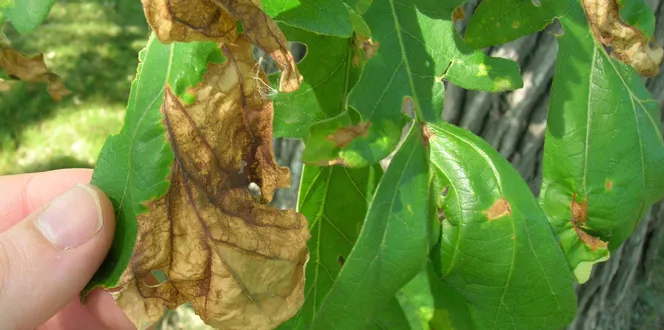Without a doubt, you’d never put your tree in harm’s way. Or at least, not on purpose.
You might be unaware of some small actions that can hurt your tree big time. And, that’s OK! The important thing is that you find out what is bad for trees now so you can make the best decisions later.
Let’s jump into a few common tree care missteps that should be avoided.
Girdling a tree
Girdling is the process of removing a thin ring of bark from around a tree. It’s usually done on fruit trees as a way of prompting them to produce more fruit. Sure, girdling can be effective. But, does it do more harm than good?
Verdict: Yep, girdling is on the list of things that kill trees. Cutting bark blocks the flow of nutrients from the leaves to roots. When roots are cut off from their food source, that’s what causes a tree to die.
Putting mulch too close to a tree's trunk
Mulch is incredibly helpful to trees. It balances out soil temperature, it conserves moisture, and it even helps control pesky weeds. All those benefits make it seem like you could never go wrong with mulch. But, that’s not quite the case. How do we harm trees with mulch?
Verdict: Mulch piled up on a tree’s trunk creates lots of moisture, causing decay. And, decayed bark is quite weak, which means the tree’s foundation won’t be sound. The good news is you can avoid these threats by properly mulching your trees and allowing a 2”-3” buffer between mulch and tree trunk.
Using nails, screws or staples on a tree
If you’re looking to make your mark on a tree, nails, screws or staples might be involved. But will poking at your tree cause damage?
Verdict: Although it is never a good idea to drill into a tree, this one’s a toss-up. Healthy, mature trees can usually withstand minor drilling or nails hammered into them, but trees that are weak for any reason, or trees that have thin bark, should not be nailed or drilled. If your tree is a good candidate, here’s how to safely drill or drive nails into a tree without hurting it.
Planting trees close together
Growing trees in close corridors—yay or nay?
Verdict: Trees need personal space! When you plant trees too close together, they’re forced to compete for water and nutrients in the soil. Plus, their sprawling roots could get in the way of each other. In the end, none of your trees will be able to thrive in these crowded growing conditions. To be safe, here’s how much space you should leave between trees.
Building over or covering a tree's roots
You might have the urge to hide unsightly tree roots. Question is, does covering roots cause damage down the line?
Verdict: It depends. Covering tree roots with concrete is a no-no. When roots are in search of space to grow, they’ll find it by any means necessary. So, concrete you’ve placed over the roots can be cracked or heaved up. Fortunately, there are effective ways to camouflage roots. Read about the best way to cover exposed tree roots.





